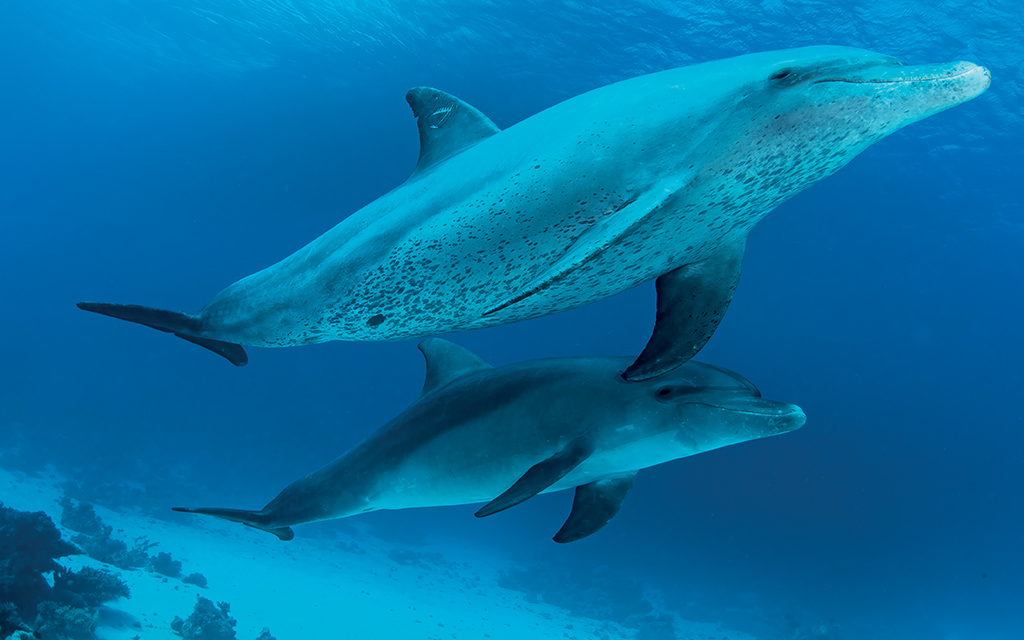
Becky Hitchin casts a scientific eye at the cetaceans, and the way their brains enable their superpowers.
We all know marine mammals are intelligent. Dolphins in particular can remember events and learn concepts, adapting their behaviour as a result of previous experiences. They communicate with each other to create complex hunting and feeding strategies, manage relationships in their pods and have intimate bonds with their young. They understand not only words, but can interpret the order of words. The signature whistles produced by dolphins even show some evidence that dolphins have a self-awareness, or the capacity to have a concept of ‘self’ and to know that one exists as an individual being.
Much of this comes about through the remarkable nature of marine mammal brains. The sperm whale has the world’s largest brain, weighing in at up to 8kg compared to human’s 1.3kg brain. However, the current record holder for total number of brain neurons – those wonderful nerves that process and deliver information - is the killer whale, with over 40 billion cortical neurons.
Pilot whales come a close second, with 32 billion, twice the number of an average human. Dolphins also have the most folded brain surface of any creature on the planet. The more folded the brain’s cortex area, the more room within the brain to house additional neurons with which to perform processing of information.
Further, marine mammal brains contain a special kind of brain cell called a spindle neuron, associated with advanced abilities such as recognising, remembering, reasoning, communicating, perceiving, adapting to change, problem-solving and understanding. What marine mammals’ brains do seem to have lost, however, is a pretty standard layer of mammalian cells that help information process from one side of the brain to the other. Why would this have happened? It seems it’s likely to be related to cetaceans’ ability to sleep with one hemisphere of the brain remaining awake while the other half sleeps. A very useful thing indeed.
dolphins have an ability to map sounds 30 times faster than humans
All these innovations in the brain feed through to the senses. Apart from river dolphins that live in murky, sediment laden waters, dolphins have good eyesight, albeit mostly in shades of black and white. But where they excel is hearing. Their upper limit of hearing is over three octaves higher than that of humans; they have an ability to map sounds 30 times faster than humans.
They can also echolocate, producing short broad-spectrum burst-pulses that sound to us like clicks. These clicks are reflected from objects of interest to the whale and provide information on food sources. But how? It all comes down to two areas of fat deposits in the head. When the animal creates the echolocation sounds, they are focused into a directional beam by the bigger of the fat deposits, known as the ‘melon’, that sits in the brain case. In turn, the echoes reflected from food sources are received at the ‘acoustic window’ fatty area in the lower jaw, where the bone is very thin and from there transmitted to the middle ear and onwards to the brain for interpretation, where there is an entire region of the brain dedicated to understanding the results of echolocation.
Whales and dolphins really are incredible creatures. Their intelligence is of an unearthly kind, almost literally, evolved and adapted to survive and thrive in their lives in the ocean. How incredibly lucky are we when we dive to be able to enter their worldview for a short while, to even hear – or feel – their communications, see their curiosity and inquisitiveness at the presence of what must be strange and awkward divers in their waters.
Article ‘Intelligence in the sea’ by Becky Hitchin first published in SCUBA magazine, Issue 136 July/August 2023.

 Author: Becky Hitchin | Posted 17 Jul 2023
Author: Becky Hitchin | Posted 17 Jul 2023


